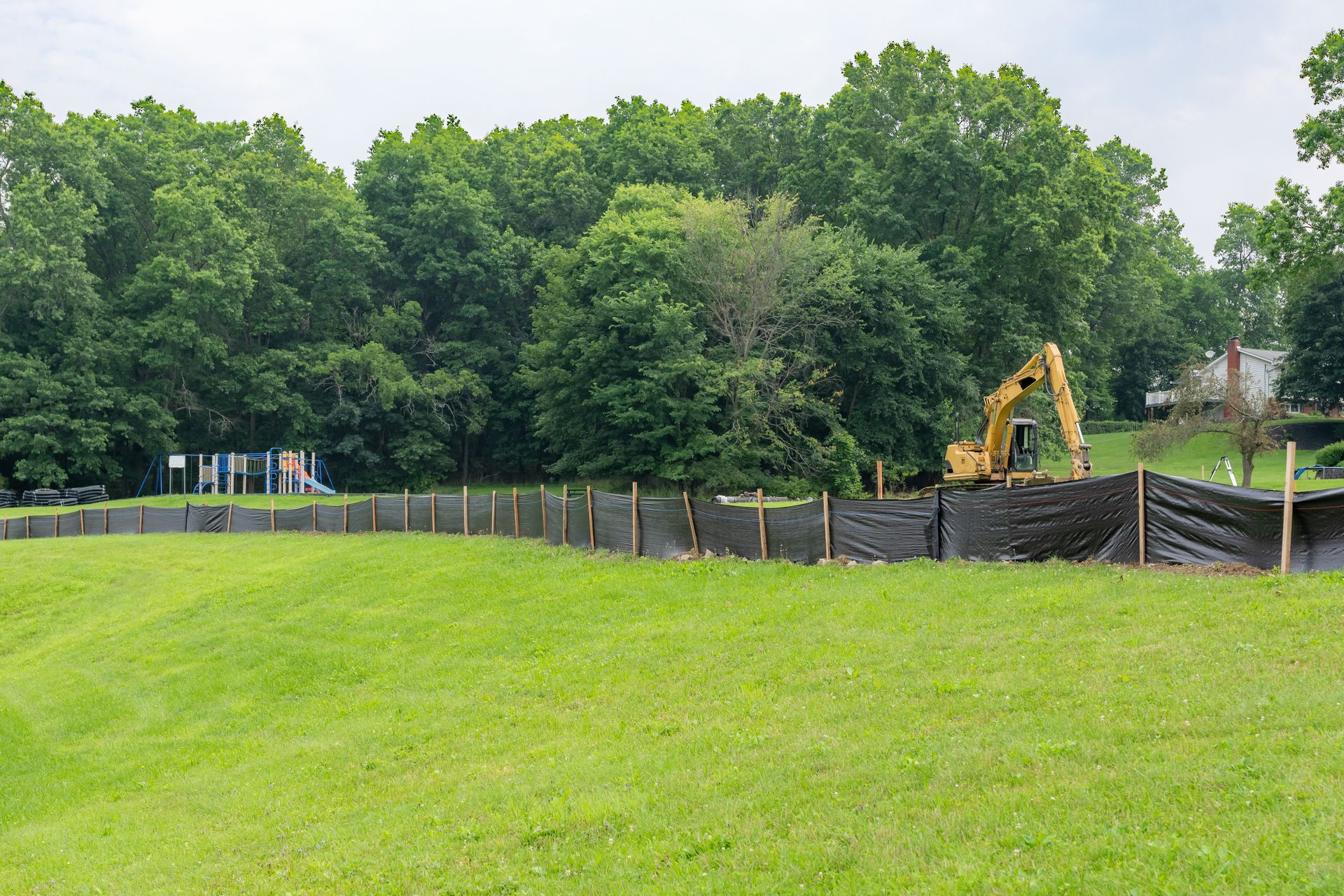Due to the impact that construction-related activities can have on nearby topsoil, erosion controls are often necessary to prevent sediment-laden water from polluting nearby surface waters.
One of the most popular forms of erosion control is silt fencing, which helps divert, slow, and filter oncoming stormwater runoff as it passes over slopes.
However, the effectiveness of silt fencing depends on when, where, and how it’s installed.
This guide will illustrate the basic principles of installing a silt fence, including when it’s needed and when to hire a commercial silt fence installer.
What Is the Purpose of a Silt Fence?
A silt fence is designed to prevent sediment runoff and soil erosion by acting as a barrier that can slow stormwater and allow fine particles to settle.
Most silt fences are simple contraptions made up of wooden stakes and geotextile fabric sturdy enough to handle large volumes of water rushing downhill.
Silt fences are generally installed around the perimeter of a worksite to prevent sediment from escaping. They are also commonly employed on slopes to slow down water and divert it away from vulnerable topsoil.
When Is a Silt Fence Required on a Construction Site?
Silt fences are one of many common best management practices of erosion control on construction sites. We generally recommend that silt fences be installed when:
- The disturbance of soil exceeds certain thresholds, such as due after clearing, grading, or excavation activities.
- The construction site is located near sensitive environmental areas, water bodies, or stormwater drainage systems.
- There is a risk of sediment runoff due to slope gradients, soil type, or weather conditions.
When Is a Silt Fence Required Near a Home?
Silt fences are also commonly used on residential properties during construction or renovation projects to reduce erosion of the topsoil.
Consider installing a silt fence or hiring a professional when stormwater discharge from neighboring construction activity threatens your garden, drainage systems, or topsoil.
Types of Silt Fences
The effectiveness of a silt fence also depends on the type of silt fence you install. Silt fences come in various forms, each tailored to specific applications and site conditions. Common types of silt fences include:
- Conventional Silt Fence: These fences consist of geotextile fabric stretched between wooden or metal stakes, offering short-term erosion control.
- Wire-Backed Silt Fence: These fences are reinforced with wire mesh or grid to enhance stability and durability, offering long-term erosion control.
- Super Silt Fence: These fences combine features of conventional silt fencing with an additional layer of geotextile fabric for increased sediment retention and filtration capacity.
Selecting the appropriate type of silt fence depends on factors such as soil type, slope gradient, flow velocity, and project duration.
How to Properly Utilize a Silt Fence
Material selection is just one aspect of proper silt fence installation. To ensure maximum effectiveness, you’ll need to decide where to install silt fencing and how much to install.
Some tips for proper silt fence utilization include:
- Installing fences downhill from disturbed areas to intercept sediment-laden runoff.
- Ensuring proper tensioning and alignment of the fence to minimize gaps and prevent bypass flow.
- Regularly inspecting and maintaining silt fences to address damage, clogging, or sediment accumulation.
- Monitoring sediment accumulation behind the fence and removing sediment as needed to maintain functionality.
- Adding complementary erosion control measures such as vegetative buffers, wattles, and check dams.
Determining how much silt fencing you need comes with different considerations. According to the EPA, 100 feet of silt fencing is required for every 10,000 square feet on a construction site.
Different Ways to Install a Silt Fence
There are a few different ways to install silt fencing into the earth, all of which require power tools and possibly professional assistance.
The most common method, trenching, requires excavating a long, thin trench to place the fence and bury the bottom portion of the geotextile material. Stakes must also be driven into the earth using a specialized tool that most people don’t have.
Why Hire a Professional to Install Your Silt Fencing
As silt fencing requires careful planning and professional assistance for installation, it makes sense to outsource this task to an environmental management company.
Entrusting the task to a qualified professional offers numerous benefits, including:
- Expertise in site assessment, erosion control planning, and regulatory compliance.
- Access to specialized equipment, materials, and techniques for efficient and effective installation.
- Assurance of proper installation techniques and adherence to industry standards.
- Timely response to changing site conditions, weather events, and regulatory requirements.
- Minimization of potential liabilities associated with improper installation or non-compliance.
Proper silt fence installation is a critical aspect of erosion control. Therefore, finding the right professional to assist you in planning and installing your silt fence is an important decision all site managers need to make before embarking on a project.
FAQs
Can I install a silt fence myself?
While DIY installation is possible, hiring a professional ensures proper installation, compliance with regulations, and optimal erosion control effectiveness. If you use the trench method of installation, you’ll also require help from an excavation company.
How long does a silt fence last?
The lifespan of a silt fence varies depending on factors such as material quality, site conditions, and maintenance practices. Generally, silt fences are designed for temporary use during construction activities and may need replacement periodically.
Are there alternatives to silt fencing for erosion control?
Alternative erosion control measures include sediment barriers, vegetative buffers, erosion control blankets, and sediment basins. The effectiveness of each option depends on site-specific conditions and project requirements.

